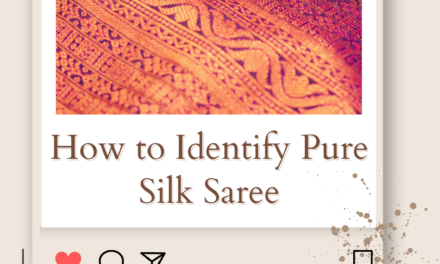How to Wash Silk Saree at Home? Silk sarees also known as Pattu sarees are prized possessions that exude grace and beauty. Proper care and maintenance are essential to preserve their luster and longevity. While professional dry cleaning is recommended for delicate silk sarees,
it is possible to wash them at home with extra care and attention. In this guide, we will provide step-by-step instructions on how to wash silk sarees to ensure they remain pristine and beautiful. Note: these guides also apply to all types of sarees.

Tips for Washing Silk Sarees at Home
| Tip | Description |
|---|---|
| Check the Label | Always read the care label attached to the saree to determine if it is suitable for handwashing or requires dry cleaning. |
| Pre-treat Stains | Gently treat any stains or spots on the saree before washing to improve the chances of complete removal. |
| Test for Colorfastness | Perform a colorfastness test on a small, inconspicuous area of the saree to ensure the colors won’t bleed during washing. |
| Gentle Handwashing | Wash the silk saree by hand using a mild detergent and lukewarm water. |
| Avoid Agitation | Handle the saree with care and avoid excessive rubbing or wringing to prevent damage to the delicate fabric. |
| Rinse Thoroughly | Rinse the saree thoroughly to remove all traces of detergent. |
| Air Dry Flat | After washing, gently squeeze out excess water and lay the saree flat to air dry in a shaded area away from direct sunlight. |
| Ironing Tips | Use a low heat setting and a pressing cloth to iron the silk saree, avoiding direct contact with the iron. |
Guide on Washing Silk Sarees at Home

- Check the care label: Before proceeding, check the care label attached to the saree for any specific instructions provided by the manufacturer. This will help you determine if the saree can be hand-washed or if it requires professional dry cleaning.
- Pre-treat stains: If you notice any stains or spots on the saree, gently pre-treat them before washing. Use a mild stain remover or a mixture of water and gentle detergent to gently dab and treat the affected areas. Allow the pre-treatment to sit for a few minutes before proceeding to the next step.
- Perform a colorfastness test: To avoid color bleeding, perform a colorfastness test on a small, inconspicuous area of the saree. Dampen a clean white cloth with water and gently rub it on the test area. If there is no color transfer, it is safe to proceed with washing the saree.
- Fill a basin with lukewarm water: Fill a basin or sink with lukewarm water and add a mild detergent specifically designed for delicate fabrics. Swirl the water gently to create a soapy solution.
- Submerge the saree: Immerse the silk saree in soapy water, ensuring it is fully submerged. Gently swirl the saree in the water, allowing the detergent to penetrate the fabric. Avoid agitating the saree vigorously to prevent damage.
- Rinse thoroughly: Drain the soapy water and refill the basin with clean lukewarm water. Submerge the saree in the fresh water and gently swirl it to rinse off any remaining detergent. Repeat this rinsing process until the water runs clear, indicating the saree is free from detergent residue.
- Remove excess water: Gently squeeze out excess water from the saree, taking care not to wring or twist it forcefully. Avoid using a dryer or wringing the saree tightly, as this can cause stretching or damage to the delicate fabric.
- Air dry flat: Lay a clean, dry towel on a flat surface and place the saree on top of it. Gently spread the saree out flat, smoothing any wrinkles or folds. Leave it to air dry in a shaded area away from direct sunlight, which can fade the colors. Avoid hanging the saree, as this can cause stretching.
- Iron with caution: Once the saree is completely dry, you can iron it to remove any remaining wrinkles. Set your iron to a low heat setting suitable for silk and place a pressing cloth or a clean cotton fabric over the saree. Iron the saree gently and avoid direct contact between the iron and the silk fabric.
Also, read:
Conclusion: Washing silk sarees at home requires careful attention to preserve their beauty and integrity. By following the guide provided, you can ensure that your silk sarees remain in excellent condition.
Remember to always check the care label, pre-treat stains, and perform a colorfastness test before washing. Handwash with a gentle detergent, rinse thoroughly, and air dry the saree flat. With proper care, your silk sarees will continue to exude elegance and charm for years to come.
FAQs on Washing Silk Sarees
Can I wash silk sarees at home?
Yes, it is possible to wash silk sarees at home, but it requires extra care and attention to ensure they are not damaged during the process.
How do I determine if a silk saree can be hand-washed?
Always check the care label attached to the saree. It will provide instructions on whether the saree can be hand-washed or if it requires professional dry cleaning.
Should I pre-treat stains before washing the silk saree?
Yes, it is recommended to gently pre-treat stains or spots on the saree before washing. Use a mild stain remover or a mixture of water and gentle detergent to treat the affected areas.
Do I need to perform a colorfastness test before washing the saree?
Yes, it is important to perform a colorfastness test on a small, inconspicuous area of the saree to ensure that the colors won’t bleed during the washing process.
Can I use regular detergent to wash silk sarees?
No, regular detergents can be harsh on silk fabric. It is recommended to use a mild detergent specifically designed for delicate fabrics.
How should I dry the silk saree after washing it?
After washing, gently squeeze out excess water and lay the saree flat to air dry. Avoid using a dryer or wringing the saree tightly, as this can cause stretching or damage.
Can I iron silk sarees after washing them?
Yes, you can iron silk sarees after they are completely dry. Use a low heat setting and place a pressing cloth or a clean cotton fabric over the saree to protect it from direct contact with the iron.
How often should I wash silk sarees?
Silk sarees should be washed sparingly to maintain their quality. Ideally, they should be cleaned only when necessary, such as when they become soiled or stained.
Can I use fabric softener on silk sarees?
It is best to avoid using fabric softener on silk sarees as it can leave a residue and affect the fabric’s natural sheen. Stick to using a gentle detergent for cleaning.
What should I do if my silk saree gets wrinkled?
To remove wrinkles, you can gently steam the saree using a handheld steamer or hang it in the bathroom while taking a hot shower to let the steam relax the wrinkles.
















The articles you write help me a lot and I like the topic